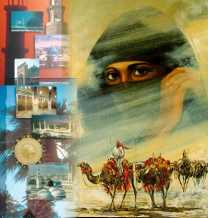Hijab
by Farhat Lal
Hijab is a very important aspect of a Muslim women's life. The word, as generally understood nowadays refers to the women's Islamic dress.
The impression of Hijab is that only the head should be covered by a scarf or other suitable garment. The fact that there is more to Hijab then clothes is over looked, the Islamic dress code should be accompanied by the correct Islamic behavior.
There are two types of Hijab, External Hijab and Internal Hijab. The external Hijab is clothes and the internal Hijab is attitude of behavior.

External Hijab
There are certain conditions which we must follow if our dress is to be considered Islamic. There are not any particular style which have been dictated. The Qur'an states:
Say to the believing women that they should not display their beauty and ornaments except what appear thereof; that they should draw their veils over their bosoms and not display their beauty except to their husbands, their father, their husband fathers, their sons, their husband sons, their brothers or their brother's and sister's sons or their women, or small children and they should not strike their feet in order to draw attention to their hidden ornaments. And O you believers! Turn all toward Allah that you may attain bliss. [Surah Nur (24:31)]
There are conditions which make clothing Islamic which are as follows:
- It should cover the whole head and body (it means the neck, forearm and ears). Except the face and hands.
- The dress must be loose enough not to describe the shape of a woman's body.
- The clothing should not attract men's attention to the women's beauty. This means that dazzling bright colour, glittery decorations and shiny material should be avoided.
- It should be thick enough so as not to show the colour of the skin. The Prophet Muhammad (Pbuh) said: "In later generation of my Ummah there will be women's who will be dressed but naked." He added that they, "will not enter into paradise even get a smell of it."
- The clothes should not resemble men's clothing. Eg Trousers.
- The clothes should not be perfumed.
- It should not be similar to the costume of non- Muslims. Hijab is the identity - the wearer is a Muslim. We should avoid wearing clothes which imitate the religious dress of others. Eg Some Muslim women's wearing Hindu-style dots on the forehead or a see through scarf.
The Women at the time of the Prophet (peace and blessings be upon him) used to wear garments consisting of cloak and head cover, whenever they were in the presence of non - Mahrem.
Some people may feel that wearing Hijab prevents women from doing a proper job. Wearing Hijab is not really such a problem, the first few weeks of wearing Hijab are admittedly the hardest but when you have started to wear it then you would never feel the need to go without the Hijab.
Internal Hijab
The internal Hijab doesn't apply to clothes, it is the whole attitude and way of behaving which goes with dress code and which is the ideal behavior of the Muslim women. Whether a Muslim women wears Hijab or not she should strive to adopt the Islamic behaviour. When we have to deal with non - Mahrem our voice should be low, we should not giggle and laugh loud in the presence of hearing of non - Mahrem men.
Hanging around in street, shopping center or place of amusement is not acceptable behaviour for a Muslim women. Hijab is not just wearing scarf and a long dress it's our attitude! The clothes should remain us to behave in an Islamic manner at all times.
